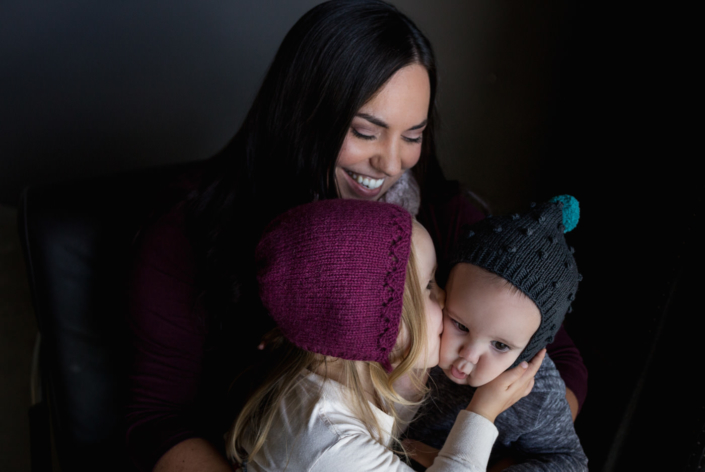Welcome to my the April guest blog! If you’re new, this a 2023 project for me adding value to your inbox every month this. Feel to catch up on back to school tips from January, stretches for Mumlife from February, and why ring slings rule from March, we’ll wait!
This one is a pretty special blog to me because my hair model bestie Ali is a talented knitwear designer and is sharing some knitwear love, and her simple washing tips. This may seem basic, but how many of us have knitwear we hardly wear because washing it is overwhelming? Ali is going to demystify it for us. And just in time too. Knitwear is amazing in autumn and winter photo shoots; I love the texture it adds. And if you’ve seen of my newborn sessions (entitled ‘Welcoming’ on the blog), you’ve seen my white machine knitted blanket I use under the babies. Fave! Is this just an excuse for us to walk down memory lane of years of shoots and thousands of images? it’s a mystery we’ll never know.
Ali is a some-time knitwear designer, currently on an extended hiatus from design work. She enjoys knitting and crocheting, and when not busy home educating her two kids and studying Japanese, loves pinning outfits, stitch ideas, and clothing repair inspiration on Pinterest. Ali may not currently be adding any new knitwear designs to her portfolio, but her whole back catalogue is available for purchase and instant download on Ravelry, and selected patterns on Etsy.
In the profile image, Ali wears Aomori scarf and Hugo wears Hugo bonnet. Pattern PDFs found on Ravelry and Etsy.
Ali wears Haru shawl. Pattern PDFs found on Ravelry.
How to care for your knitwear
The weather is starting to turn. Days are getting shorter, nights are getting longer, and the air has a crisp quality to it that immediately takes my mind to the delicious piles of knitwear that have been hibernating in my closet. There are so many upsides to living in Perth, including our magnificent weather, but the season of cool days in this sweet city is a little short-lived for my liking. Because of this, I relish the opportunity to wrap myself and my loved ones in knitwear while that season lasts. Is there anyone on earth who doesn’t enjoy clothing that feels like a warm hug?
The days of scratchy jumpers with necklines that barely fit over your head are, thankfully, almost completely behind us. We truly are spoilt for choice when it comes to knitwear these days, with fibres to suit all tastes and sensitivities, and styles to suit every taste. For those who knit or crochet, we are almost overwhelmed by choice when it comes to the availability of digital patterns we can access to create our own clothes. Oversized jumpers, colourful beanies, chunky scarves, and flowing wraps add fun, comfort, and interest to our chosen looks, and it can be a lot of fun to put together outfits for a family photo shoot that incorporates knitwear.
I will admit, however, that owning and loving knitwear has a small downside: caring for it. While some mass-produced knits can handle a gentle machine wash, a lot still require handwashing. This is especially true for hand-made knitwear, and anything made from wool or silk. Washing and caring for your knits need not be intimidating, despite this, and I’m going to share with you my preferred method for washing all knitwear. It’s worth the effort to properly care for your knits; a little bit of extra time and energy taken to wash and store them properly means a longer life for your garments.
Hugo wears Vem sweater. Pattern PDFs found on Ravelry and Etsy.
WASHING YOUR KNITWEAR
Note: The following washing method can be utilised for all fibres and all knitted fabrics. Some care labels will state that a gentle machine wash is ok for a particular garment, but most of the time I will still choose to handwash these pieces. If you do decide to go ahead and machine wash, use only cold water, a very small amount of appropriate laundry detergent, and low spin. Do not machine wash knits with other laundry, and always gently lay flat to dry. I don’t recommend machine washing knits if you have a top loader with an agitator.
Step 1: Detergent
Add a very small amount of wool-safe, no-rinse liquid laundry detergent to a bucket or sink, then fill with cold water.
Step 2: Add the knits
Put your knits into the water, and very gently press them below the surface of the water. Please note that I recommend washing one item at a time, unless you are absolutely sure that the pieces you’re washing are colour-fast.
JJ and Violet wear Form beanie. Pattern PDF found on Ravelry.
Step 3: Hands off!
Walk away! I like to leave my knits soaking for a minimum of half an hour. I have been known to forget about them for several hours, and this is totally ok. Please do not swish or otherwise agitate your knits while they are wet, as this may cause them to felt.
Step 4: Drain
It’s time to drain the water. If you’re using a bucket, gently tip the water out while holding the garment in the bucket. Once the water has drained out, you can give the garment a very gentle squeeze to remove some water, but this isn’t necessary.
Teng Teng wears Fuyu shawl and Lachlan wears Aki bonnet. Pattern PDFs found on Ravelry and Etsy.
Step 5: Squeeze
Take a large towel, and fold it in half. Lie it on the floor, and put your knitwear onto it. Carefully arrange the knit so that it is somewhat flat, but don’t fuss too much. It’s ok if it’s still mostly in a bundle. Take a second large towel, fold it in half, and put it on top of the knit and bottom towel. Roll your towel-knit-towel sandwich into a tight cylinder in order to squeeze out as much water as possible. I like to step on my rolled-up towel as this really helps to remove excess water without agitating the garment.
Step 6: Lay flat
Unroll the towels, and lay your knit flat to dry on a clothes horse. Gently shape the knit while it’s laying flat. If your garment is ribbed, take extra care not to stretch it out (washing helps return stretched out ribbing to its original size).
That’s it! It may seem like a little bit of fussing, but in reality, this process takes barely a few minutes of my time.
Annika and Henry wear Theodore beanie. Pattern PDF found on Ravelry and Etsy.
As for storage: never, ever hang your knitwear. Always fold knitted garments, and store them in a closet or drawers away from harsh light and anything that might snag them. I also recommend using some kind of insect repellent in your closet or drawers to keep bugs away from natural fibres, particularly if your clothing storage is in the open. If you want to return your knitwear to an as-new condition, consider purchasing a de-piller and giving your knits a good shave once every season or so.
Knitwear, whether hand-made or shop-bought, is so delightful. My hope is that, with these simple care instructions, you’ll no longer be intimidated by knitwear and instead be inspired to pull those special pieces out of your closet more often.
Thank you Ali! After the rainbow crocheted blanket (made by me!) washing incident of 2013, I now follow Ali’s method religiously. You can see her most recent family photo sesh here, and check out her patterns on Ravelry, and Etsy, for yourself or your fave knitter! You may see a fair bit of imagery you recognise too 😉
Now here’s a fave shoot we did thanks to our beautiful friends Brandy and Rach.
Brandy wears Suginami Cowl, Layla wears berry Caris bonnet, Hunter wears charcoal Hugo bonnet, Emily wears mustard Caris bonnet. Pattern PDFs found on Ravelry and Etsy.
Look forward to capturing your family story soon xxx
– If you see partially loaded images, try clearing your internet cache in your settings by clicking “clear cache” and coming back. Thank you! –
Sign up to my mailing list to receive occasional emails about seasonal specials, including when minis are coming up, and receive 2 free images with your next session!































